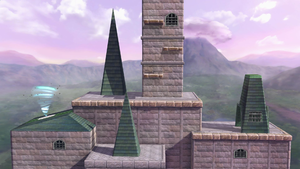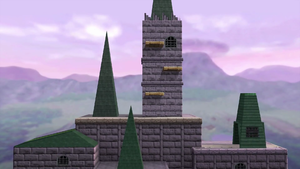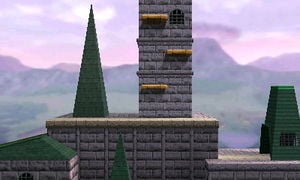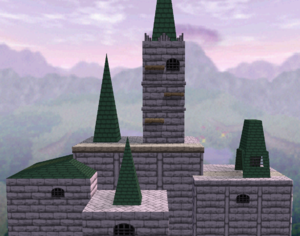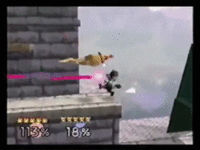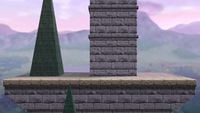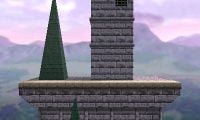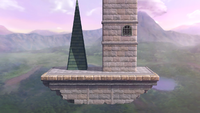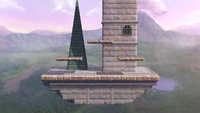Hyrule Castle: Difference between revisions
Aidanzapunk (talk | contribs) (Undid edit by INoMed:) |
m (Swapping the names since "Hyrule Castle" is the most recent name) |
||
| (132 intermediate revisions by 72 users not shown) | |||
| Line 1: | Line 1: | ||
{{ArticleIcons| | {{ArticleIcons|ssb=y|ssb4=y|ultimate=y}} | ||
{{Infobox Stage | {{Infobox Stage | ||
| | |subtitle = ''The Legend of Zelda'' | ||
|name | |name = Hyrule Castle{{gameIcon|SSB}}{{gameIcon|SSBU}}<br>Hyrule Castle (64){{gameIcon|SSB4}} | ||
|image | |image = {{tabber|title1=Ultimate|content1=[[File:SSBU-Hyrule Castle.png|300px]]|title2=Wii U|content2=[[File:SSBUHyruleCastle64.PNG|300px]]|title3=3DS|content3= [[File:SSB3DSHyruleCastle.jpg|300px]]|title4=64|content4=[[File:HyruleCastleSSB.png|300px]]}} | ||
|caption | |caption = [[File:ZeldaSymbol.svg|50px|class=invert-dark]]<br>Hyrule Castle as it has appeared in the ''Smash'' series. | ||
|universe | |universe = {{uv|The Legend of Zelda}} | ||
|games | |games = ''[[SSB]]''<br>''[[SSB4]]''<br>''[[Ultimate]]'' | ||
|availability = [[Starter stage|Starter]] (''SSB'' and ''Ultimate'')<br>[[Downloadable content|Downloadable]] (''SSB4'') | |||
|availability = [[Starter stage|Starter]] (''SSB'')<br>[[Downloadable content|Downloadable]] (''SSB4'') | |cratetype = Normal | ||
|cratetype | |maxplayers = 4 (''SSB'' and 3DS)<br>[[8-Player Smash|8]] (Wii U and ''Ultimate'') | ||
|maxplayers = [[8-Player Smash|8]] | |ssbmusic = ''{{SSBMusicLink|7|Hyrule Castle Stage}}'' | ||
|for3dsmusic = Main: ''{{SSB4MusicLink|The Legend of Zelda|Hyrule Castle Stage}}''<br>Alternate: ''{{SSB4MusicLink|The Legend of Zelda|The Legend of Zelda Medley}}'' | |||
|ssbsingles | |forwiiumusic = ''{{SSB4MusicLink|The Legend of Zelda|Hyrule Castle Stage}}''<br>''{{SSB4MusicLink|The Legend of Zelda|The Legend of Zelda Medley}}''<br>''{{SSB4MusicLink|The Legend of Zelda|Hyrule Field Theme (Original)|Hyrule Field Theme}}''<br>''{{SSB4MusicLink|The Legend of Zelda|Overworld Theme (The Legend of Zelda)}}''<br>''{{SSB4MusicLink|The Legend of Zelda|Overworld Theme (A Link to the Past)}}''<br>''{{SSB4MusicLink|The Legend of Zelda|Termina Field}}'' | ||
|ssbdoubles | |ultimatemusic = [[List of SSBU Music (The Legend of Zelda series)|''The Legend of Zelda'' series music]]<br>Main: ''{{SSBUMusicLink|The Legend of Zelda|Overworld Theme - The Legend of Zelda (64)}}''<br>Alternate: ''{{SSBUMusicLink|The Legend of Zelda|Death Mountain}}'' | ||
|ssbsingles = Banned (US ruleset)<br>[[Banned stage|Banned]] (Japanese ruleset) | |||
|ssbdoubles = [[Banned]] (US ''National'' ruleset)<br>[[Banned stage|Banned]] (Japanese ruleset) | |||
|ssb4singles = Banned | |ssb4singles = Banned | ||
|ssb4doubles = Banned | |ssb4doubles = Banned | ||
|interwiki | |ultimatesingles= Banned | ||
|interwikiname= Zelda Wiki | |ultimatedoubles= Banned | ||
|interwikipage= Hyrule Castle | |interwiki = zeldawiki | ||
|interwikiname = Zelda Wiki | |||
|interwikipage = Hyrule Castle | |||
}} | }} | ||
{{cquote|''A tornado spins about the stage, wreaking havoc on all that cross its path.'' | {{cquote|''A tornado spins about the stage, wreaking havoc on all that cross its path.'' | ||
|cite=Super Smash Bros<nowiki>'</nowiki> | |cite=''[[Super Smash Bros.]]''<nowiki>'</nowiki> instruction manual}} | ||
'''Hyrule Castle''' ({{ja|ハイラル城|Hairaru-jō}}, ''Hyrule Castle'') is a playable stage in ''[[Super Smash Bros.]]'' and home to {{SSB|Link}}. It did not return in ''[[Super Smash Bros. Melee]]'', although another Hyrule-based stage, [[Temple]], appeared. | '''Hyrule Castle''' ({{ja|ハイラル城|Hairaru-jō}}, ''Hyrule Castle'') is a playable stage in ''[[Super Smash Bros.]]'' and home to {{SSB|Link}}. It did not return in ''[[Super Smash Bros. Melee]]'' or ''[[Super Smash Bros. Brawl]]'', although another {{s|zeldawiki|Hyrule}}-based stage, [[Temple]], appeared in both games. | ||
Hyrule Castle returned as [[downloadable content]] in both versions of ''[[Super Smash Bros. 4]]'' on July 31st, 2015, along with [[Peach's Castle]]. Like other returning stages from the [[Super Smash Bros.|first Smash game]], some of the textures are slightly higher in quality, but the general overall primitive look of the original is retained. | Hyrule Castle returned as [[downloadable content]] in both versions of ''[[Super Smash Bros. 4]]'' on July 31st, 2015, along with [[Peach's Castle]]. Like other returning stages from the [[Super Smash Bros.|first ''Smash Bros.'' game]], some of the textures are slightly higher in quality, but the general overall primitive look of the original is retained. The stage also appears in ''[[Super Smash Bros. Ultimate]]''. | ||
In ''Super Smash Bros.'', it is the first stage in [[1P Game]], and Link is the first to be fought. | |||
==Stage overview== | |||
The stage has a large main platform in the center. Three platforms float about midway across the main platform, with the middle to the right of the top and bottom ones. The bottom platform is just high enough for {{mvsub|Captain Falcon|SSB|up smash|poss=y}} to be able to hit opponents standing on it. The platforms can allow combos such as the [[Stairway to Heaven]] to be performed for longer, and situational vertical KOs can also occur on the top platform, KOing at unusually low percentages. Characters such as {{SSB|Mario}} can also make use of the platforms to land vertical finishers, such as an up smash in Mario's case. Connected to the left of the main platform is a slightly lower, slanted platform. To the right of the main platform is a lower, connected platform with a dark green gazebo-like structure in the middle of it. Characters may stand on top of it, but may not jump through it. This portion of the stage is known in competitive play as the tent (see below for more information). | The stage has a large main platform in the center. Three platforms float about midway across the main platform, with the middle to the right of the top and bottom ones. The bottom platform is just high enough for {{mvsub|Captain Falcon|SSB|up smash|poss=y}} to be able to hit opponents standing on it. The platforms can allow combos such as the [[Stairway to Heaven]] to be performed for longer, and situational vertical KOs can also occur on the top platform, KOing at unusually low percentages. Characters such as {{SSB|Mario}} can also make use of the platforms to land vertical finishers, such as an up smash in Mario's case. Connected to the left of the main platform is a slightly lower, slanted platform. To the right of the main platform is a lower, connected platform with a dark green gazebo-like structure in the middle of it. Characters may stand on top of it, but may not jump through it. This portion of the stage is known in competitive play as the tent (see below for more information). | ||
In competitive play, Fox generally dominates on this stage due to its large size and high amount of space allowing him to use his [[blaster]] to [[projectile camp]] much easier than on {{SSB|Dream Land}}. {{SSB|Link}} is also much more effective on this stage for a similar reason. Both are also less vulnerable to [[gimp]]s and offstage combos on this stage, particularly Link, who relies on his projectiles to [[space]] against opponents and avoid being hit offstage. | In competitive play, Fox generally dominates on this stage due to its large size and high amount of space allowing him to use his [[Blaster (Fox)|blaster]] to [[projectile camp]] much easier than on {{SSB|Dream Land}}. {{SSB|Link}} is also much more effective on this stage for a similar reason. Both are also less vulnerable to [[gimp]]s and offstage combos on this stage, particularly Link, who relies on his projectiles to [[space]] against opponents and avoid being hit offstage. | ||
===Tent=== | ===Tent=== | ||
[[File:SSB64 Greenhouse Combo.gif|thumb|{{Sm|Isai}}'s "[[Greenhouse]]" combo.]] | [[File:SSB64 Greenhouse Combo.gif|left|thumb|{{Sm|Isai}}'s "[[Greenhouse]]" combo.]] | ||
The | The structure to the right of the main platform, commonly referred to as the '''Tent''', the '''Combo Tent''', or the '''Greenhouse''', is known for its ability to start powerful combos, especially in ''Smash 64''. By using aerials or throws that knock opponents into the walls of the Tent, powerful combos can be started, many of which can be finished with KO moves. This was made famous by {{Sm|Isai}}'s "[[Greenhouse]]" combo with {{SSB|Pikachu}}, which involves using multiple up tilts, a back throw against the left wall, back aerial against the structure, up smash on the main platform (where the opponent will get knocked after being hit by the back aerial), and then a [[Thunderspike]]. | ||
Forward and back throws can be used to [[chaingrab]] the opponents against the walls to rack up more damage, and the up tilts may also be skipped if the opponent is already in the right position for a [[grab]]. Many other characters can perform their own variations of this combo. For example, {{SSB|Fox}} can use his back throw against the left wall to combo into a down aerial, which can subsequently lead into a regrab to continue the chain. He can also use the same throw to combo into an up aerial, which is a KO setup, especially against [[floaty]] characters. | Forward and back throws can also be used to [[chaingrab]] the opponents against the walls to rack up more damage, and the up tilts may also be skipped if the opponent is already in the right position for a [[grab]]. Many other characters can perform their own variations of this combo. For example, {{SSB|Fox}} can use his back throw against the left wall to combo into a down aerial, which can subsequently lead into a regrab to continue the chain. He can also use the same throw to combo into an up aerial, which is a KO setup, especially against [[floaty]] characters. | ||
Another advanced tent combo performed with Fox is the "shine pillar up smash" combo, popularized by {{Sm|The Z}}. It involves launching the opponent to the top of the structure with an up tilt, jumping up to the top of the structure, cancelling aerial momentum with a [[shine]], then immediately using an up smash to KO the opponent while they are still in [[hitstun]]. | Another advanced tent combo performed with Fox is the "shine pillar up smash" combo, popularized by {{Sm|The Z}}. It involves launching the opponent to the top of the structure with an up tilt, jumping up to the top of the structure, cancelling aerial momentum with a [[shine]], then immediately using an up smash to KO the opponent while they are still in [[hitstun]]. | ||
| Line 42: | Line 47: | ||
Moves such as {{mvsub|Pikachu|SSB|up aerial|poss=y}} and {{mvsub|Captain Falcon|SSB|back aerial|poss=y}} can also be used to repeatedly knock an opponent against the structure. | Moves such as {{mvsub|Pikachu|SSB|up aerial|poss=y}} and {{mvsub|Captain Falcon|SSB|back aerial|poss=y}} can also be used to repeatedly knock an opponent against the structure. | ||
==Features== | ===Features=== | ||
The only terrain effect are the four tornadoes, commonly called "nados" or the "nado" in the ''Smash 64'' community, which spawn randomly over the stage. They tend to last around 10-20 seconds, and move randomly in a direction, although they may suddenly speed up and home in on a character. If caught, a character is held for about | The only terrain effect are the four tornadoes, commonly called "nados" or the "nado" in the ''Smash 64'' community, which spawn randomly over the stage. They tend to last around 10-20 seconds, and move randomly in a direction, although they may suddenly speed up and home in on a character. If caught, a character is held for about two seconds before being dealt 14% and thrown upward, KOing between 65% and 130% depending on weight of character and location of the tornado. The tornado's knockback is similar to a throw in which it cannot be [[SDI]]'d. It is possible to attack someone while they are in a tornado as well, and it is possible to hit the opponent with an aerial when they are released, including a [[meteor smash]] to knock opponents back into a tornado to rack up more damage. Tornados, due to their large vertical knockback, can also be used by {{SSB|Pikachu}} players to set up Thunderspikes if the opponent is caught in one. If a tornado speeds up and/or catches a character, it tends to spend less time on stage. The image to the side show the locations of the four tornados/nados spawns. | ||
In ''Smash 4'', the tornadoes no longer speed up randomly and stay at a constant slow speed. | In ''Smash 4'', the tornadoes no longer speed up randomly and stay at a constant slow speed. CPUs may try to dodge the tornado or simply just run into it. | ||
==Ω | ===Ω forms and Battlefield form=== | ||
In ''Super Smash Bros. 4'', the [[Ω form]] is set on a flat version of Hyrule Castle that extends below the [[blast line]]. The three [[soft platform]]s of the regular form and the gazebo-like structure are removed, and tornados do not appear. | |||
In ''Super Smash Bros. Ultimate'', the Ω form and [[Battlefield form]] are identical to ''SSB4'''s Ω form; however, the main platform does not extend below the blast line and is resized and reshaped to match {{SSBU|Final Destination}} and {{SSBU|Battlefield}}, respectively. The three soft platforms of the Battlefield form are based on the ones of the regular form. | |||
<gallery widths="200px"> | <gallery widths="200px"> | ||
WiiUHyruleCastleOmega.jpg | WiiUHyruleCastleOmega.jpg|Ω form in ''Super Smash Bros. for Wii U''. | ||
SSB3DSHyruleCastleOmega.jpg| | SSB3DSHyruleCastleOmega.jpg|Ω form in ''Super Smash Bros. for Nintendo 3DS''. | ||
File:SSBU-Hyrule_CastleOmega.png|Ω form in ''Super Smash Bros. Ultimate''. | |||
File:SSBU-Hyrule CastleBattlefield.png|Battlefield form in ''Super Smash Bros. Ultimate''. | |||
</gallery> | </gallery> | ||
{{clrl}} | |||
===Hazards Off=== | |||
With hazards off in ''Ultimate'', the tornadoes do not appear. | |||
==Origin== | |||
[[File:HyruleCastleOoT.png|left|thumb|Hyrule Castle as it appears in ''[[The Legend of Zelda: Ocarina of Time]]''.]] | |||
This stage is based on {{s|zeldawiki|Hyrule Castle}}, a recurring location in ''The Legend of Zelda'' series first appearing in ''{{s|zeldawiki|The Legend of Zelda: A Link to the Past}}'', with this stage's design based on its appearance in ''{{s|zeldawiki|The Legend of Zelda: Ocarina of Time}}''. | |||
In ''Ocarina of Time'', [[Young Link]] travels to Hyrule Castle to meet the young [[Princess Zelda]] upon the dying request of the {{s|zeldawiki|Great Deku Tree}}. Link sneaks past the patrolling guards and meets Zelda in the castle's courtyard where she spies on [[Ganondorf]], the king of the Gerudo, swearing his fealty to her father, the King. It is here that Princess Zelda teams up with Young Link to protect the titular [[zeldawiki:Ocarina of Time (item)|Ocarina of Time]] and the {{s|zeldawiki|Spiritual Stones}} from Ganondorf, both of which act as the key to access the {{s|zeldawiki|Sacred Realm}} which contains the series' sacred item, the [[Triforce]]. After meeting with Princess Zelda, Link is tasked by her Sheikah guardian {{s|zeldawiki|Impa}} to travel to {{s|zeldawiki|Death Mountain}} to retrieve the Spiritual Stone of Fire from the {{s|zeldawiki|Goron}}s. | |||
In ''{{s|zeldawiki|The Legend of Zelda}}'', a {{s|zeldawiki|recorder}} can be played to summon a tornado, which teleports Link to dungeons dependent on the direction he faces. This is the only game in the series before ''Ocarina of Time'' to feature a tornado. | |||
This stage features multiple elements taken from ''The Legend of Zelda'' series. The main stage takes place on the roof of Hyrule Castle in ''Ocarina of Time'', albeit with some differences. The center tower features platforms, while the right side of the stage features a gazebo structure. The stage's background features Death Mountain, a volcanic mountain in ''The Legend of Zelda'' series located in the northern region of Hyrule, with its design based on its appearance in ''Ocarina of Time''. | |||
The tornado from ''The Legend of Zelda'' appears as a stage hazard, which can damage and throw a character upwards. | |||
{{clrl}} | |||
== | ==Tournament legality== | ||
According to the American ''Smash 64'' ruleset, Hyrule Castle has | ===''Super Smash Bros.''=== | ||
According to the American ''Smash 64'' ruleset, Hyrule Castle has been considered to be a banned stage as of 2014. Although it was considered to be the second most neutral stage, behind {{SSB|Dream Land}}, for a long time, the disadvantages of the hazards and features of the stage have become more apparent in the more recent [[metagame]]. The tornado hazards on the stage are known for appearing completely randomly, without any indication of the position where the tornado appeared if the tornado is outside of the screen's reach. The tornadoes also speed up at random times, which can catch even more wary players offguard, and fully cover options that would have otherwise been completely safe. The stage's large size also allows significant [[camping]] in certain positions, as in certain matchups it is possible for one player to camp on the far left of the stage and make it extremely difficult for the opponent to approach safely: a primary example is {{SSB|Kirby}} against {{SSB|Captain Falcon}}, as Kirby can stay on the far left of the stage and space up tilts and back airs to cover all of Captain Falcon's safe approach options, with [https://www.youtube.com/watch?v=D52KGq4jlMQ&t=12m57s a match] between {{sm|Mew2King}} and {{sm|Stranded}} involving this technique being infamous. It is also possible for several characters to camp the top platform, such as {{SSB|Pikachu}} and {{SSB|Kirby}}: this was made famous by {{sm|SuPeRbOoMfAn}} who had a [https://www.youtube.com/watch?v=eiQp5w-9IAE 52 minute game] with {{Sm|Gerson}}. | |||
{{Sm|Bane}} is often credited for being a significant contributor to the banning of Hyrule Castle, detailing the disadvantages of the stage in a [[SmashBoards]] thread named [http://smashboards.com/threads/a-case-against-hyrule.340054/ A Case Against Hyrule], and also comparing the stage's legality to other stages. However, Hyrule Castle remains a popular stage among many players due to the unique combos possible in the tent portion and the strategies that are usable due to the stage's structure. Due to the [[Gentleman's Rule]], Hyrule Castle can still be seen in tournaments if both players agree to playing on it. | {{Sm|Bane}} is often credited for being a significant contributor to the banning of Hyrule Castle, detailing the disadvantages of the stage in a [[SmashBoards]] thread named [http://smashboards.com/threads/a-case-against-hyrule.340054/ A Case Against Hyrule], and also comparing the stage's legality to other stages. However, Hyrule Castle remains a popular stage among many players due to the unique combos possible in the tent portion and the strategies that are usable due to the stage's structure. Due to the [[Gentleman's Rule]], Hyrule Castle can still be seen in tournaments if both players agree to playing on it. | ||
Hyrule Castle has always been banned in the Japanese ruleset, as {{SSB|Dream Land}} is considered the only neutral and legal stage in said ruleset. The Peruvian ruleset | Hyrule Castle has always been banned in the Japanese ruleset, as {{SSB|Dream Land}} is considered the only neutral and legal stage in said ruleset. The Peruvian ruleset contrasted with this for a long time, as Hyrule Castle was considered to be the main stage up until Boom went to Tacna. Hyrule has now been phased out entirely for Dream Land, due to the same reasoning. | ||
After a significant period of not seeing competitive play, Hyrule Castle was made legal for ''64'' tournament play at {{Trn|The Off-Season 2}}, as a charity incentive, alongside [[Saffron City]]. | |||
== | ===''Super Smash Bros. 4''=== | ||
Unlike in ''SSB'', Hyrule Castle has been banned since launch. Alongside the cave of life, disruptive tornado and unfair advantage for certain characters, there were simply enough legal stages in this game to not consider it as a legal stage. | |||
===''Super Smash Bros. Ultimate''=== | |||
Hyrule Castle remains banned in ''Ultimate'' for the same reasons as ''Smash 4''. There are also now even more stages, further distancing it as potentially legal. | |||
==Video== | |||
{{ | {{#widget:YouTube|id=9KRE3YIa0fs}} | ||
==Gallery== | ==Gallery== | ||
===''Super Smash Bros. ''=== | |||
<gallery> | <gallery> | ||
Tornado.png|The four spawn points of the tornado. Note the location of the tornado on the upper platform that can kill at very low percents. | Tornado.png|The four spawn points of the tornado. Note the location of the tornado on the upper platform that can kill at very low percents. | ||
SSB64 Fox Pillar Usmash.gif|{{Sm|The Z}}'s "Fox Pillar Up Smash" combo. | SSB64 Fox Pillar Usmash.gif|{{Sm|The Z}}'s "Fox Pillar Up Smash" combo. | ||
</gallery> | </gallery> | ||
===''Super Smash Bros. Ultimate''=== | |||
<gallery> | |||
SSBUWebsiteGanondorf5.jpg|{{SSBU|Ganondorf}} and {{SSBU|Zelda}} [[taunting]] on the stage in ''Ultimate''. | |||
SSBUWebsiteMiiFighter2.jpg|The {{SSBU|Mii Swordfighter}} using their dash attack near {{SSBU|Villager}} on the stage in ''Ultimate''. | |||
SSBUWebsiteSimon4.jpg|{{SSBU|Simon}} using [[Axe]] on {{SSBU|Bowser}} on this stage in ''Ultimate''. | |||
</gallery> | |||
==Names in other languages== | |||
{{langtable | |||
|ja={{ja|ハイラル城|Hairaru-jō}} | |||
|jaM=Hyrule Castle | |||
|en=Hyrule Castle | |||
|fr=Château d'Hyrule | |||
|frM=Hyrule Castle | |||
|es=Castillo de Hyrule | |||
|esM=Hyrule Castle | |||
|de=Schloss Hyrule | |||
|deM=Hyrule Castle | |||
|it=Castello di Hyrule | |||
|itM=Hyrule Castle | |||
|nl=Kasteel Hyrule | |||
|nlM=Hyrule Castle | |||
|ru={{rollover|Замок Хайрул|Zamok Khayrul|?}} | |||
|ruM=Hyrule Castle | |||
|ko={{rollover|하이랄 성|Hairal Seong|?}} | |||
|koM=Hyrule Castle | |||
|zh_cn={{rollover|海拉鲁城堡|Hǎilālǔ Chéngbǎo|?}} | |||
|zh_cnM=Hyrule Castle | |||
|zh_tw={{rollover|海拉魯城堡|Hǎilālǔ Chéngbǎo|?}} | |||
|zh_twM=Hyrule Castle | |||
|pt=Castelo de Hyrule | |||
|ptM=Hyrule Castle | |||
}} | |||
==Trivia== | ==Trivia== | ||
*In '' | *In ''Super Smash Bros.'', [[Maxim Tomato]]es never appear on this stage, making the [[Heart Container]]s from ''The Legend of Zelda'' universe the only major [[healing]] [[item]] to appear. | ||
*This is the only stage from ''The Legend of Zelda'' universe to have ever been considered tournament legal in both singles and doubles. | *This is the only stage from ''The Legend of Zelda'' universe to have ever been considered tournament legal in both singles and doubles. | ||
*In | *In {{Forwiiu}}, five of the six available tracks are either ''The Legend of Zelda'''s main theme or a remix of said music. | ||
**However, all six songs contain the main theme in some way. | **However, all six songs contain the main theme in some way. | ||
*Hyrule Castle is the only stage to have no background characters. | *Hyrule Castle is the only stage in ''Smash 64'' to have no background characters. | ||
*In ''Ultimate'', the grey tower is treated as being a background object, while the green spire next to it is treated as a foreground object, despite the latter being further back. | |||
*In ''[[Super Smash Bros. 4]]'', in [[Training Mode]], if a [[Smash Ball]] is spawned, Tornadoes will disappear. | |||
*[ | *When playing as {{SSBU|Pokémon Trainer}}, the trainer will stand on the center roof if they are Player 1 or 2, or on the lower right roof if they are Player 3 or 4. | ||
*The following [[Assist Trophy|Assist Trophies]] cannot appear on this stage: [[Skull Kid]], [[Andross]] and [[Devil]]. Additionally, [[Lugia]] cannot be summoned here. | |||
*In ''Super Smash Bros. Ultimate'', the background remains fixed in place when the camera is moving, creating the optical illusion that the castle itself is tilting or rotating during camera movements. | |||
{{SSBStages}} | {{SSBStages}} | ||
{{SSB4Stages}} | {{SSB4Stages}} | ||
{{SSBUStages}} | |||
{{Zelda universe}} | {{Zelda universe}} | ||
[[Category:Stages]] | [[Category:Stages]] | ||
[[Category:Stages (SSB4-3DS)]] | [[Category:Stages (SSB4-3DS)]] | ||
[[Category:Stages (SSB4-Wii U)]] | [[Category:Stages (SSB4-Wii U)]] | ||
[[Category:Past stages]] | [[Category:Past stages]] | ||
[[Category:Downloadable content]] | [[Category:Downloadable content]] | ||
[[es:Castillo de Hyrule]] | |||
Latest revision as of 21:39, December 3, 2024
| The Legend of Zelda Hyrule Castle Hyrule Castle (64) | |
|---|---|
 Hyrule Castle as it has appeared in the Smash series. | |
| Universe | The Legend of Zelda |
| Appears in | SSB SSB4 Ultimate |
| Availability | Starter (SSB and Ultimate) Downloadable (SSB4) |
| Crate type | Normal |
| Maximum players | 4 (SSB and 3DS) 8 (Wii U and Ultimate) |
| Article on Zelda Wiki | Hyrule Castle |
| “ | A tornado spins about the stage, wreaking havoc on all that cross its path. | ” |
| —Super Smash Bros.' instruction manual | ||
Hyrule Castle (ハイラル城, Hyrule Castle) is a playable stage in Super Smash Bros. and home to Link. It did not return in Super Smash Bros. Melee or Super Smash Bros. Brawl, although another Hyrule-based stage, Temple, appeared in both games.
Hyrule Castle returned as downloadable content in both versions of Super Smash Bros. 4 on July 31st, 2015, along with Peach's Castle. Like other returning stages from the first Smash Bros. game, some of the textures are slightly higher in quality, but the general overall primitive look of the original is retained. The stage also appears in Super Smash Bros. Ultimate.
In Super Smash Bros., it is the first stage in 1P Game, and Link is the first to be fought.
Stage overview[edit]
The stage has a large main platform in the center. Three platforms float about midway across the main platform, with the middle to the right of the top and bottom ones. The bottom platform is just high enough for Captain Falcon's up smash to be able to hit opponents standing on it. The platforms can allow combos such as the Stairway to Heaven to be performed for longer, and situational vertical KOs can also occur on the top platform, KOing at unusually low percentages. Characters such as Mario can also make use of the platforms to land vertical finishers, such as an up smash in Mario's case. Connected to the left of the main platform is a slightly lower, slanted platform. To the right of the main platform is a lower, connected platform with a dark green gazebo-like structure in the middle of it. Characters may stand on top of it, but may not jump through it. This portion of the stage is known in competitive play as the tent (see below for more information).
In competitive play, Fox generally dominates on this stage due to its large size and high amount of space allowing him to use his blaster to projectile camp much easier than on Dream Land. Link is also much more effective on this stage for a similar reason. Both are also less vulnerable to gimps and offstage combos on this stage, particularly Link, who relies on his projectiles to space against opponents and avoid being hit offstage.
Tent[edit]
The structure to the right of the main platform, commonly referred to as the Tent, the Combo Tent, or the Greenhouse, is known for its ability to start powerful combos, especially in Smash 64. By using aerials or throws that knock opponents into the walls of the Tent, powerful combos can be started, many of which can be finished with KO moves. This was made famous by Isai's "Greenhouse" combo with Pikachu, which involves using multiple up tilts, a back throw against the left wall, back aerial against the structure, up smash on the main platform (where the opponent will get knocked after being hit by the back aerial), and then a Thunderspike.
Forward and back throws can also be used to chaingrab the opponents against the walls to rack up more damage, and the up tilts may also be skipped if the opponent is already in the right position for a grab. Many other characters can perform their own variations of this combo. For example, Fox can use his back throw against the left wall to combo into a down aerial, which can subsequently lead into a regrab to continue the chain. He can also use the same throw to combo into an up aerial, which is a KO setup, especially against floaty characters.
Another advanced tent combo performed with Fox is the "shine pillar up smash" combo, popularized by The Z. It involves launching the opponent to the top of the structure with an up tilt, jumping up to the top of the structure, cancelling aerial momentum with a shine, then immediately using an up smash to KO the opponent while they are still in hitstun.
Moves such as Pikachu's up aerial and Captain Falcon's back aerial can also be used to repeatedly knock an opponent against the structure.
Features[edit]
The only terrain effect are the four tornadoes, commonly called "nados" or the "nado" in the Smash 64 community, which spawn randomly over the stage. They tend to last around 10-20 seconds, and move randomly in a direction, although they may suddenly speed up and home in on a character. If caught, a character is held for about two seconds before being dealt 14% and thrown upward, KOing between 65% and 130% depending on weight of character and location of the tornado. The tornado's knockback is similar to a throw in which it cannot be SDI'd. It is possible to attack someone while they are in a tornado as well, and it is possible to hit the opponent with an aerial when they are released, including a meteor smash to knock opponents back into a tornado to rack up more damage. Tornados, due to their large vertical knockback, can also be used by Pikachu players to set up Thunderspikes if the opponent is caught in one. If a tornado speeds up and/or catches a character, it tends to spend less time on stage. The image to the side show the locations of the four tornados/nados spawns.
In Smash 4, the tornadoes no longer speed up randomly and stay at a constant slow speed. CPUs may try to dodge the tornado or simply just run into it.
Ω forms and Battlefield form[edit]
In Super Smash Bros. 4, the Ω form is set on a flat version of Hyrule Castle that extends below the blast line. The three soft platforms of the regular form and the gazebo-like structure are removed, and tornados do not appear.
In Super Smash Bros. Ultimate, the Ω form and Battlefield form are identical to SSB4's Ω form; however, the main platform does not extend below the blast line and is resized and reshaped to match Final Destination and Battlefield, respectively. The three soft platforms of the Battlefield form are based on the ones of the regular form.
Hazards Off[edit]
With hazards off in Ultimate, the tornadoes do not appear.
Origin[edit]
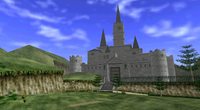
This stage is based on Hyrule Castle, a recurring location in The Legend of Zelda series first appearing in The Legend of Zelda: A Link to the Past, with this stage's design based on its appearance in The Legend of Zelda: Ocarina of Time.
In Ocarina of Time, Young Link travels to Hyrule Castle to meet the young Princess Zelda upon the dying request of the Great Deku Tree. Link sneaks past the patrolling guards and meets Zelda in the castle's courtyard where she spies on Ganondorf, the king of the Gerudo, swearing his fealty to her father, the King. It is here that Princess Zelda teams up with Young Link to protect the titular Ocarina of Time and the Spiritual Stones from Ganondorf, both of which act as the key to access the Sacred Realm which contains the series' sacred item, the Triforce. After meeting with Princess Zelda, Link is tasked by her Sheikah guardian Impa to travel to Death Mountain to retrieve the Spiritual Stone of Fire from the Gorons.
In The Legend of Zelda, a recorder can be played to summon a tornado, which teleports Link to dungeons dependent on the direction he faces. This is the only game in the series before Ocarina of Time to feature a tornado.
This stage features multiple elements taken from The Legend of Zelda series. The main stage takes place on the roof of Hyrule Castle in Ocarina of Time, albeit with some differences. The center tower features platforms, while the right side of the stage features a gazebo structure. The stage's background features Death Mountain, a volcanic mountain in The Legend of Zelda series located in the northern region of Hyrule, with its design based on its appearance in Ocarina of Time.
The tornado from The Legend of Zelda appears as a stage hazard, which can damage and throw a character upwards.
Tournament legality[edit]
Super Smash Bros.[edit]
According to the American Smash 64 ruleset, Hyrule Castle has been considered to be a banned stage as of 2014. Although it was considered to be the second most neutral stage, behind Dream Land, for a long time, the disadvantages of the hazards and features of the stage have become more apparent in the more recent metagame. The tornado hazards on the stage are known for appearing completely randomly, without any indication of the position where the tornado appeared if the tornado is outside of the screen's reach. The tornadoes also speed up at random times, which can catch even more wary players offguard, and fully cover options that would have otherwise been completely safe. The stage's large size also allows significant camping in certain positions, as in certain matchups it is possible for one player to camp on the far left of the stage and make it extremely difficult for the opponent to approach safely: a primary example is Kirby against Captain Falcon, as Kirby can stay on the far left of the stage and space up tilts and back airs to cover all of Captain Falcon's safe approach options, with a match between Mew2King and Stranded involving this technique being infamous. It is also possible for several characters to camp the top platform, such as Pikachu and Kirby: this was made famous by SuPeRbOoMfAn who had a 52 minute game with Gerson.
Bane is often credited for being a significant contributor to the banning of Hyrule Castle, detailing the disadvantages of the stage in a SmashBoards thread named A Case Against Hyrule, and also comparing the stage's legality to other stages. However, Hyrule Castle remains a popular stage among many players due to the unique combos possible in the tent portion and the strategies that are usable due to the stage's structure. Due to the Gentleman's Rule, Hyrule Castle can still be seen in tournaments if both players agree to playing on it.
Hyrule Castle has always been banned in the Japanese ruleset, as Dream Land is considered the only neutral and legal stage in said ruleset. The Peruvian ruleset contrasted with this for a long time, as Hyrule Castle was considered to be the main stage up until Boom went to Tacna. Hyrule has now been phased out entirely for Dream Land, due to the same reasoning.
After a significant period of not seeing competitive play, Hyrule Castle was made legal for 64 tournament play at The Off-Season 2, as a charity incentive, alongside Saffron City.
Super Smash Bros. 4[edit]
Unlike in SSB, Hyrule Castle has been banned since launch. Alongside the cave of life, disruptive tornado and unfair advantage for certain characters, there were simply enough legal stages in this game to not consider it as a legal stage.
Super Smash Bros. Ultimate[edit]
Hyrule Castle remains banned in Ultimate for the same reasons as Smash 4. There are also now even more stages, further distancing it as potentially legal.
Video[edit]
Gallery[edit]
Super Smash Bros. [edit]
The Z's "Fox Pillar Up Smash" combo.
Super Smash Bros. Ultimate[edit]
The Mii Swordfighter using their dash attack near Villager on the stage in Ultimate.
Names in other languages[edit]
Trivia[edit]
- In Super Smash Bros., Maxim Tomatoes never appear on this stage, making the Heart Containers from The Legend of Zelda universe the only major healing item to appear.
- This is the only stage from The Legend of Zelda universe to have ever been considered tournament legal in both singles and doubles.
- In Super Smash Bros. for Wii U, five of the six available tracks are either The Legend of Zelda's main theme or a remix of said music.
- However, all six songs contain the main theme in some way.
- Hyrule Castle is the only stage in Smash 64 to have no background characters.
- In Ultimate, the grey tower is treated as being a background object, while the green spire next to it is treated as a foreground object, despite the latter being further back.
- In Super Smash Bros. 4, in Training Mode, if a Smash Ball is spawned, Tornadoes will disappear.
- When playing as Pokémon Trainer, the trainer will stand on the center roof if they are Player 1 or 2, or on the lower right roof if they are Player 3 or 4.
- The following Assist Trophies cannot appear on this stage: Skull Kid, Andross and Devil. Additionally, Lugia cannot be summoned here.
- In Super Smash Bros. Ultimate, the background remains fixed in place when the camera is moving, creating the optical illusion that the castle itself is tilting or rotating during camera movements.
| Stages in Super Smash Bros. | |
|---|---|
| Starter stages | Congo Jungle · Dream Land · Hyrule Castle · Peach's Castle · Planet Zebes · Saffron City · Sector Z · Yoshi's Island |
| Unlockable stage | Mushroom Kingdom |
